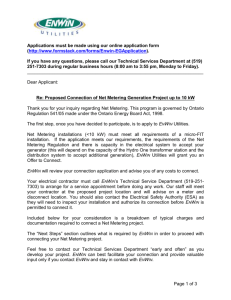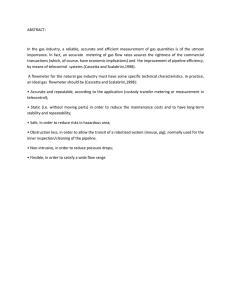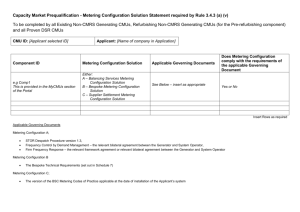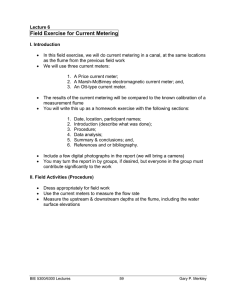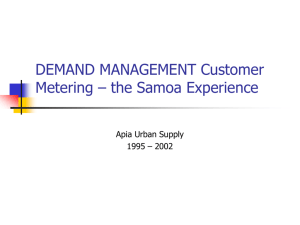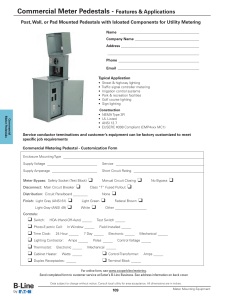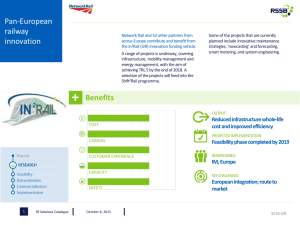Perform maintenance on a metering system on a gas transmission
advertisement
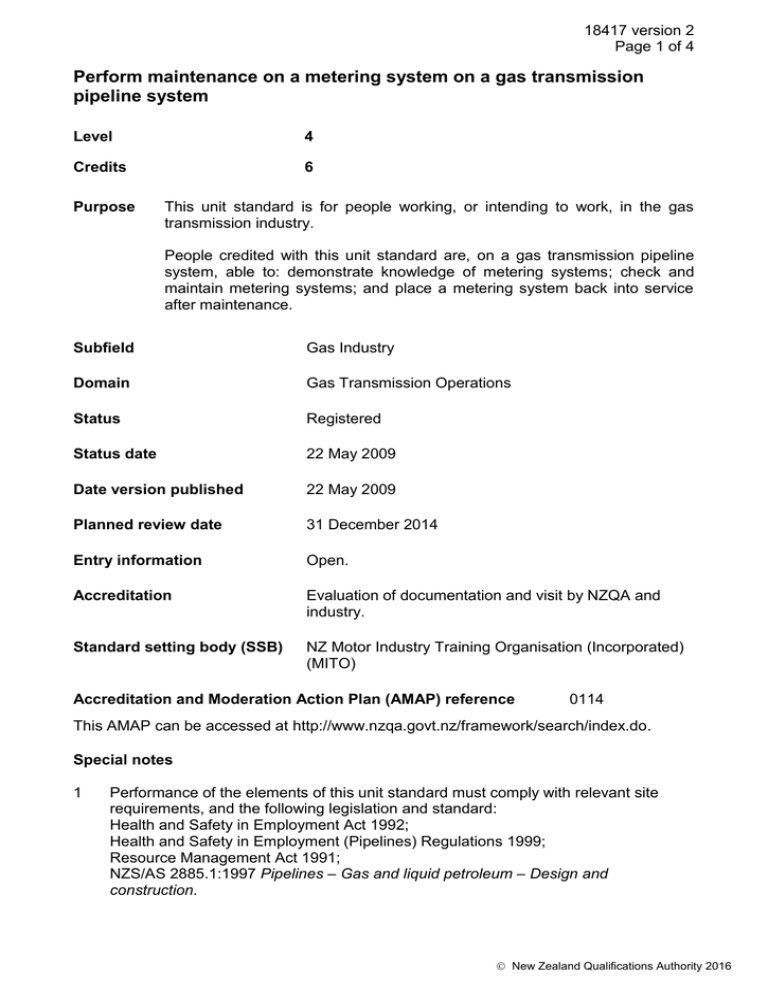
18417 version 2 Page 1 of 4 Perform maintenance on a metering system on a gas transmission pipeline system Level 4 Credits 6 Purpose This unit standard is for people working, or intending to work, in the gas transmission industry. People credited with this unit standard are, on a gas transmission pipeline system, able to: demonstrate knowledge of metering systems; check and maintain metering systems; and place a metering system back into service after maintenance. Subfield Gas Industry Domain Gas Transmission Operations Status Registered Status date 22 May 2009 Date version published 22 May 2009 Planned review date 31 December 2014 Entry information Open. Accreditation Evaluation of documentation and visit by NZQA and industry. Standard setting body (SSB) NZ Motor Industry Training Organisation (Incorporated) (MITO) Accreditation and Moderation Action Plan (AMAP) reference 0114 This AMAP can be accessed at http://www.nzqa.govt.nz/framework/search/index.do. Special notes 1 Performance of the elements of this unit standard must comply with relevant site requirements, and the following legislation and standard: Health and Safety in Employment Act 1992; Health and Safety in Employment (Pipelines) Regulations 1999; Resource Management Act 1991; NZS/AS 2885.1:1997 Pipelines – Gas and liquid petroleum – Design and construction. New Zealand Qualifications Authority 2016 18417 version 2 Page 2 of 4 2 Definition Company procedures refer to the documented methods for performing work activities and include health and safety, environmental, site requirements, and quality management requirements. They may refer to manuals, codes of practice, or policy statements. Elements and performance criteria Element 1 Demonstrate knowledge of metering systems on a gas transmission pipeline system. Performance criteria 1.1 The need for a metering system on a gas transmission pipeline system is explained. Range 1.2 The component parts and types of metering systems are identified and each component’s function is explained in relation to the type of metering system. Range 1.3 may include but is not limited to – meter tube valving, positive displacement type meter, velocity type meter, mass type meter, orifice plate, flow transmitter, pressure transmitter, temperature transmitter, density analyser, specific gravity analyser, chromatograph, flow corrector, flow computer. Documentation for maintaining a metering system is located and explained in accordance with company procedures. Range 1.4 may include but is not limited to – custody transfer, process flow indication, check metering, leak detection, reconciliation. may include but is not limited to – maintenance management system; manufacturer’s operating instructions, company safety procedures, sales agreements, regulatory requirements, current calibration certificates. Potential hazards associated with metering system maintenance are identified and the steps to control them are explained in accordance with company procedures. Range may include but is not limited to – flammable product, high pressure, loss of product supply to customer, company emergency procedures, loss of customer data supply, metering inaccuracies. New Zealand Qualifications Authority 2016 18417 version 2 Page 3 of 4 Element 2 Check and maintain metering systems on a gas transmission pipeline system. Performance criteria 2.1 Planned activities are communicated with appropriate personnel prior to performing maintenance on metering systems. Range 2.2 Safety checks and pre-start checks are conducted to determine the operational condition of the metering equipment in accordance with company procedures and manufacturer’s instructions. Range 2.3 may include but is not limited to – leak checks, alarm checks, equipment status, computer programme content checks. Calibration checks and adjustments are carried out to ensure the accuracy of the metering equipment in accordance with company procedures and manufacturer’s instructions. Range 2.4 personnel may include but are not limited to – control room, area technicians, data processing and billing group, customers. may include but is not limited to – calibration equipment, laboratory accuracy certificates, accuracy requirements, calibration gases, flow correction systems. Incorrect application and operation of equipment and procedures are described in terms of consequences. Range may include but is not limited to – metering system inaccuracies, flow restrictions, unstable processes. Element 3 Place a metering system back into service after maintenance on a gas transmission pipeline system. Performance criteria 3.1 Checks for correct connection and ready for service state are carried out in accordance with company procedures. Range 3.2 may include but is not limited to – isolation valving, alarms, purging, sampling systems, vents, equalising valves, utilities. Communication of the intended work activities with appropriate personnel prior to the placing of the metering system back into service is carried out in accordance with company procedures. Range may include but is not limited to – control room, customer, area technicians. New Zealand Qualifications Authority 2016 18417 version 2 Page 4 of 4 3.3 The metering system is placed back into service in accordance with company procedures. 3.4 The metering system is monitored on-line to ensure correct operation after being placed back into service. Range 3.5 monitoring may include but is not limited to – alarms, flow rate indication, flow correction verification checks, data processing and billing issues. Meter installation documentation is completed and communication is carried out in accordance with company procedures. Please note Providers must be accredited by NZQA, or an inter-institutional body with delegated authority for quality assurance, before they can report credits from assessment against unit standards or deliver courses of study leading to that assessment. Industry Training Organisations must be accredited by NZQA before they can register credits from assessment against unit standards. Accredited providers and Industry Training Organisations assessing against unit standards must engage with the moderation system that applies to those standards. Accreditation requirements and an outline of the moderation system that applies to this standard are outlined in the Accreditation and Moderation Action Plan (AMAP). The AMAP also includes useful information about special requirements for organisations wishing to develop education and training programmes, such as minimum qualifications for tutors and assessors, and special resource requirements. Comments on this unit standard Please contact the NZ Motor Industry Training Organisation (Incorporated) (MITO) info@mito.org.nz if you wish to suggest changes to the content of this unit standard. New Zealand Qualifications Authority 2016
